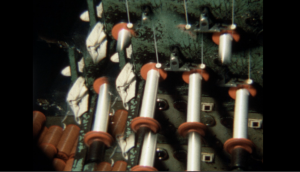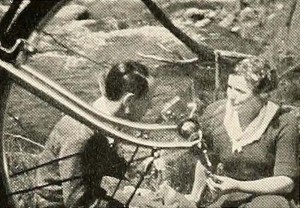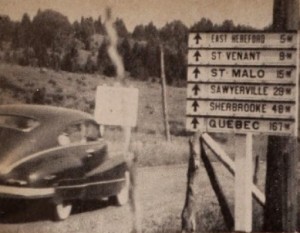
Itsasontziko xikotak egiteko prozesuari buruzko filma.
Una película sobre el proceso de hacer las cuerdas/amarras de los barcos.
A film about the process of making the strings/moorings of ships.
"Tying A Dry Salmon Fly, 300 ft., 16mm., was awarded special mention because of its unusual subject matter and because of the uniformly fine technique with which it is portrayed. Mr. Brock, both a fisherman and a firmer, has brought one hobby to the aid of another as he shows, with a straightforward continuity, the nice art of fly tying. Working almost entirely in extreme closeups, he overcame the serious problem of limited depth of focus by a canny concentration of his light sources on the tiny subject. In this manner, he was able so to stop down the lens as to achieve maximum definition and depth of field." Movie Makers, Dec. 1931, 685.

"The current and widespread revival of interest in cycling is the subject of Under Your Own Power, by Sidney Moritz. Carefully planned, attractively photographed in color and neatly edited, the production is a pleasing and happy record of bright days in the summer sun. Mr. Moritz has shrewdly remembered in his film the predominant human interest of this leisured sport, as well as the lovely scenic vistas to which it leads, and has embroidered both of these subjects with distinctive angles and some successful "effect" shots framed by cycle wheels. Amusing, effective and well worded titles in color round out this highly entertaining etude of modern wheeling." Movie Makers, Dec. 1937, 630.
doc. scientifico"/scientific documentary
Excursión a los montes de Urbia y Aralar. El filme muestra un paisaje maravilloso por los senderos del parque natural de Aralar y una acampada en las praderas de hierba verde de Urbia, una ruta clásica entre montañeros que incluye el paso por localidades emblemáticas.
An excursion to the Urbia and Aralar mounts. The film depicts a wonderful landscape through the paths of the Aralar natural park, and a camping trip through the green prairies of Urbia, a classic route for mountaineers that includes passing through emblematic places.
documentario"/documentary

"'Vacation Highlights,' as the title implies, is a record of a vacation trip, but instead of the usual array of catch-as-can shots which make up so many vacation record films, Terry Manos has given this excellently photographed narrative substance by employing inserts of a letter to his wife and daughter, describing his trip, and a number of tie-in shots of the two to knit the whole into a pleasant continuity. The picture is remarkable, not so much from its narrative standpoint as for its consistency in exposure. There is not a measurable difference in exposure in any scene throughout the picture. The picture depicts the start of the trip by automobile, which takes the travelers across the U.S. border into Canada and thence through the province of Quebec. On the return trip they visit such interesting sights as a wood pulp mill and the famed Ausabel Chasm, in upper New York. The camera treatment of the pulpwood sequence and of the Chasm scenes definitely mark this filmer as a photographer of promise. Manos used a 16mm. Bolex camera and Kodachrome daylight type film." American Cinematographer, Apr. 1950, 134.
"The Vein of Iron by Peter B. Crombie, a PSA member of Oak Lawn, Ill. Peter took a most inanimate object as his subject but through unusual angles and lighting and appropriate choice of music came up with a very interesting film. This 5-minute 8mm film won for him an Honorable Mention" PSA Journal, Nov. 1970, 38.
documentary
Documentary
Total Pages: 79